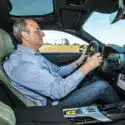The successor and the successful
We knew the chaps from the Jaguar Daimler Heritage Trust had arrived some time before we saw them. The straight six bark of a D-type is not easy to mistake, even when there are two of them travelling in convoy. Appropriately, the two Ds had not arrived at MIRA on a transporter but had been driven up by road, their legs, apparently, looking forward to a bit of a stretch.
This would be remarkable enough for any old customer D-type but these two are among the most precious in the world. The later, long-nose car is a works team car and was driven to 6th place in the 1957 Le Mans by Duncan Hamilton while the short-nose D-type is perhaps the most fascinating of them all: It is the first ever D-type, the prototype from which Britain’s most evocative sports-racing car was developed. They’re both a few minutes late. Even D-types are delayed by rush hour traffic.
I’d come to MIRA to drive the XJ13 but the opportunity to compare Jaguar’s most and least successful racing cars was not going to be passed up. Unlike the irreplaceable and unique XJ13, the D-types came with neither rev limit nor instructions other than to enjoy.
Finding common ground between front-engined and a mid-engined sportscar separated by a decade which saw some of the greatest advances in chassis and tyre capability in the history of the car is not easy. One look at the 13.5 inch thick rear wheels of the XJ13 compared to the skinny rims of the D-type suggested these two might share not much more than a badge.
In fact, it’s not like that. It is to be remembered that the same group of people from Sir William Lyons through Malcolm Sayer to Norman Dewis were responsible for the commissioning, design and development of both D-type and XJ13 and their signatures remain clear on both cars. Their engines, for instance, share similar characteristics with both 1954, 3.4-litre straight six and 1965, 5-litre V12 being chiefly torqueladen powerplants, pouring it on all the way from 2500rpm, not needing to wait for high-rev histrionics before delivering their urge. Both also have the unmistakable feel of a Jaguar racing car: quick, comfortable and properly balanced. They’re also both strong, a trait not just Norman Dewis found cause to thank over the years.
The more remarkable comparison lies between the two D-types. In the two short years that separates them, the car was transformed, not by process of radical redesign but by the continual evolution required to keep a team winning in one of the most competitive forums on earth. The prototype D-type feels not unlike a conventional road-going sports car of the era, albeit rather quicker. It turns into corners quite gently, rolls a little and feels as if it would be equally at home in the wide open spaces of Europe as hurling around a race-track.
The long-nose D-type is a different proposition altogether. Its extra pace is truly startling and you realise that it wasn’t simply its extraordinary aerodynamic efficiency (its CD factor was just 0.29) which took it above 180mph at Le Mans. This car has real power, about 280bhp from its big-valve engine, and accelerates in much the same relentless fashion as a modern Porsche 911 Turbo. It’s also more confident in curves, feeling sharper and more willing to indulge in the throttle-conducted cornering for which the breed has become so famous.
Of the three, the long-nose is most accessible and, within the confines of MIRA’s Dunlop handling circuit, the most enjoyable too, providing the punch the prototype lacked without the awesome sense of responsibility that comes as standard everytime you hit the starter switch on the XJ13.
All these cars are on permanent display at the Jaguar Daimler Heritage Trust in Browns Lane alongside 104 other luminaries from the history of Jaguar (and its associated marques) starting with the oldest surviving Austin Swallow and stretching up to its newest recruit, the final Jaguar to be fitted with a V12 engine. Other highlights include a C-type, a lightweight E-type, the world famous rallying XK120 ‘NUB 120’ and, of course, the Le Mans winning Jaguar XJR-9LM from 1988. In addition to the cars there are many thousands of photographs, original drawings and the official company archive.
Free tours encompass not just a trip around the museum but also the factory production facility too. You cannot just turn up as the tours are by appointment only and the waiting list is long despite the trust’s staff cracking through 1500 tours every month. Large groups and individuals are welcome and interested parties should contact Mrs Val King on 01203 202058.

